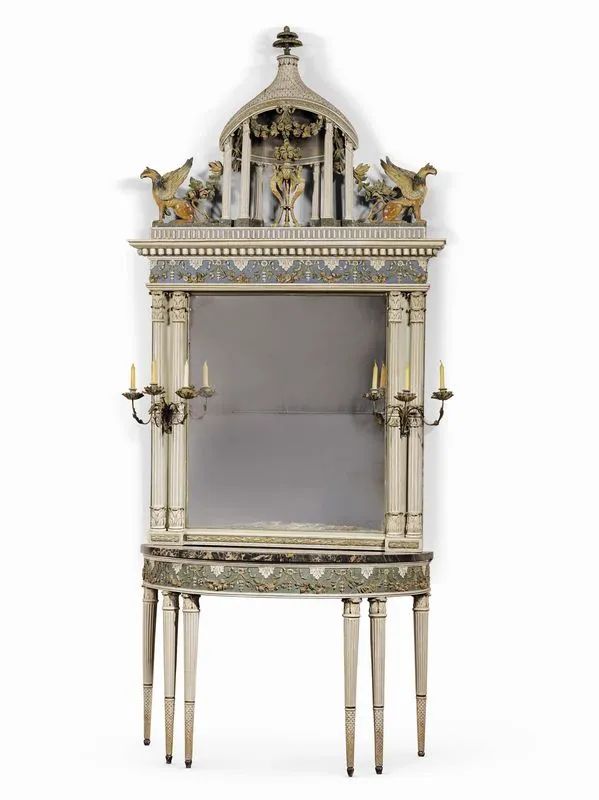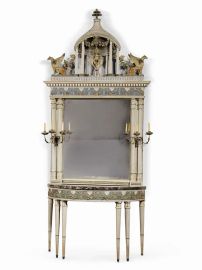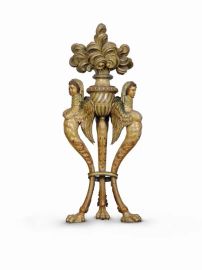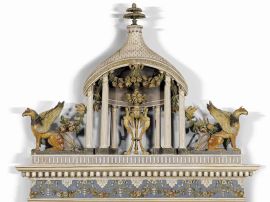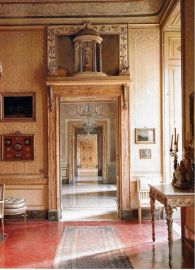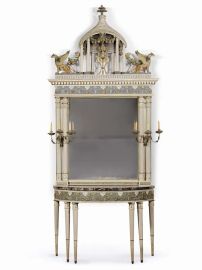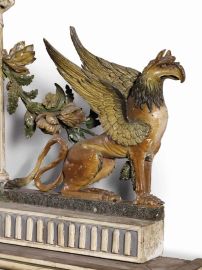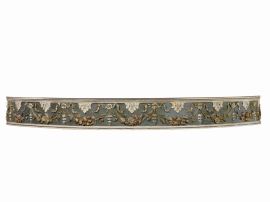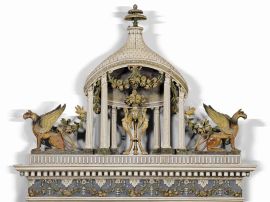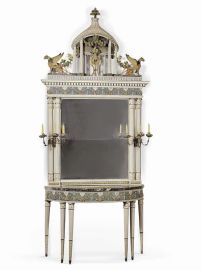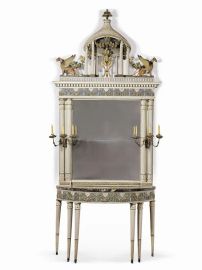PAIR OF CONSOLE TABLES WITH MIRROR, NAPLES, END-18TH CENTURY
PAIR OF CONSOLE TABLES WITH MIRROR
NAPLES, END-18TH CENTURY
carved, painted and gilded wood, portoro marble top; console table 97x138x62 cm, mirror 242x148 cm
Provenance
Taranto, Valva d’Ayala Palace;
Rome, del Balzo di Presenzano Collection
Bibliography
A. Gonzàlez-Palacios, “Mobili napoletani del Settecento”, in M. Riccòmini (edited by), Scritti per Eugenio. 27 testi per Eugenio Riccòmini, Bologna 2017, pp. 220-226
This pair of semi-circular console tables with a portoro marble top stands on six tapered legs (four front legs and two back legs), entirely white-lacquered and fluted in the centre. An imbricate motif is present in the inferior part, while the capitals with acanthus leaves support the large band under the top. The light blue band is decorated with polychromed festoons and clusters with ribbons, interspersed with acanthus leaves descending from the top.
The large mirrors, white lacquered on a light blue background, are framed on both sides by two semi-columns, fluted like the console table's legs and decorated with acanthus leaves on the base, at the centre and at the top.
The same band motif of the console tables is reproduced both on the base of the top, in a simpler way, and on the higher part of the mirrors, in a more richly decoration with an egg-and-dart denticulate moulding double frame.
The most scenographic and architecturally spectacular part of the composition is represented by the circular small temple in perspective, raising upon six small fluted columns sustained by bases and topped by capitals which hold an imbricated cupola, centred by tripods with harpies to hold a steaming vase. At the sides, two griffins facing out are joined to the small temple by a festoon with flowers. This lively polychrome composition accentuates the great craftsmanship of the engraver.
According to Alvar Gonzàlez-Palacios, who has recently published the description of these two magnificent pieces of furniture (Mobili napoletani del Settecento, Bologna 2017, pp. 220-226), “these console tables are the result of the extraordinary quality reached by the furniture manufacturing in Naples at the end of the 18th century. They resemble the pieces of furnishing made for the royal Bourbon family in that period and, in particular, the furniture destined to the residence of Ferdinand IV and Maria Carolina of Villa Favorita in Resina and the numerous furnishings donated for the wedding of the hereditary Prince Francis with his cousin, the Archduchess Maria Clementina of Austria in 1797".
The lively polychromy, characteristic of the above-mentioned pieces, is a constant element also in the numerous pieces of furniture held today in the Reggia of Caserta like, for example, a pair of polychrome drawers with arabesques and small flowers on a greyish background, or in another group of furniture in Caserta decorated with polychrome reliefs on a light-coloured background.
Alvar González-Palacios also discovered that the royal craftsman Antonio Pittarelli was paid to "gild and paint" some pieces of furniture for the Royal Apartments in Caserta at the end of the eighteenth century. "The technique applied by the artisan", the scholar states, "consisted in: painting with four hands, two with oil paints and two with white spirit [...] depicting flowers and a scene". In 1781, another royal craftsman, the gilder Bartolomeo di Natale was paid to "gild two sofas and two lounge chairs in the first chamber after the Cabinet of the Queen". Carlo Vanvitelli, son of the famous Luigi, also collaborated to the production of all these works. The oval wall mirror standing on a semi-circular table, held today in Caserta, is very similar to our two console tables in both their polychromy and in the type of carving that combines figurative and architectural elements with flowers.
After having analysed these polychrome console tables from the decorative point of view, it is now worth focusing on their rare structure: the tables can be compared, for example, with some overdoors of the Davalos Palace in Naples (see fig. 1), characterized by similar small temples with a central statue, that, according to Chiara Garzya (Interni neoclassici a Napoli, Naples 1978, pp. 47-48) may have been designed by the architect Mario Gioffredo (1718-1785).
Alvar Gonzàlez-Palacios (Il Tempio del Gusto, Milan 1984, p. 265, fig. 206, tav. LXVII) makes other two interesting comparisons: the console table from Villa della Favorita in Palermo and today in the Museum of Capodimonte has a semi-circular top and six legs distributed in pairs on the front and single legs on the back, and then some stools, surely coming from Naples and today at Villa della Favorita in Palermo, which have similar harpies holding a vase similar to our small temple.
Even if only few and fragmentary sources exist about the owners of these two important console tables, it is known that they belonged to Valva d'Ayala Palace in Taranto and that they are today part of the prestigious collection of del Balzo di Presenzano in Rome, a noble family documented since the 10th century (see fig. 2), coming from Les Baux de Provence in Provence and descending from the cadet branch of the Lords of Baux. The family of del Balzo gained so much power in the Kingdom of Naples to be mentioned among the seven most important families of the reign. Progenitor of the family was Pontius I, Viscount of Arles, whose descendants were the Viscounts of Marseilles and Pontius III juvenis, Lord of Les Baux (981).
From them descended the del Balzo branch, that arrived in Italy in 1265 after the Count of Provence, Charles I of Anjou. From them several branches had developed and today the only direct descendants from Bianchino del Balzo, cadet son of Francis I, Duke of Andria and of Sveva Orsini, are the Presenzano and Caprigliano families. Francis I was the father of Vincenzo, who continued the line of the Barons of Santa Croce (today extinct), and of Francis, progenitor of the Barons and then of the Dukes of Schiavi (today extinct). From them come the Dukes of Presenzano (Privilege conferred by the Emperor Charles VI of Habsburg on January 27th, 1734 in favour of Giacinto del Balzo) and the Dukes of Caprigliano (first privilege conferred by King Charles II of Habsburg on July 8th, 1696 in favour of Vincenzo I of the Balzo and second privilege conferred by the King Charles III of Bourbon on November 30th, 1749 in favour of Antonio I Lorenzo del Balzo).
